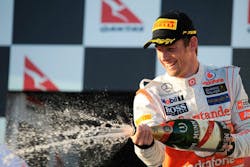Pirelli’s 2012-specification tires delivered on their promise to provide a greater variety of race strategies by decreasing the performance gaps between the compounds this year. The new versions of the P Zero Yellow soft and P Zero White medium were nominated for the Australian Grand Prix, but the drivers had very little dry running with them before the start, as Friday’s free practice sessions in Albert Park were characterized by rain.
The top finishers adopted a two-stop strategy for the race, as was the case last year, but with the pace of the medium and the soft compound only differing by around 0.5 seconds per lap, the way in which they used the tires was different – with some drivers favoring two stints on the soft tire and others preferring two stints on the medium. Sauber driver Sergio Perez once more was the only person to adopt a one-stop strategy, starting on the medium tire and changing to the soft on lap 24, to claim eighth place.
One of the turning points of the race was a safety car on lap 36, which bunched up the field and allowed Red Bull Racing’s Sebastian Vettel to claim second place by passing McLaren driver Lewis Hamilton in the pits. Up to that point McLaren’s tire strategy had been working perfectly, with the team choosing to pit both cars on the same lap for their second stops just before the safety car. When the safety car came in with only 16 laps to go, all the drivers apart from the Toro Rossos were on the P Zero White medium tires.
At the restart, race leader Jenson Button demonstrated the rapid warm-up time of the medium compound even in the cool conditions of the afternoon by pulling out a second within the first sector, to eventually claim his third victory in Australia. Vettel, who finished runner-up, had adopted a completely different strategy by using the soft tire during his medium stint. Last year, Vettel’s winning margin was 22 seconds; this year Button won by just over two seconds.
Throughout the final 10 laps, the top four drivers were covered by just over five seconds, with the final podium places remaining undecided right up to the final lap. A long first stint – which took him all the way up to second place at one point – was a vital ingredient in boosting former World Champion Kimi Raikkonen from 18th place on the grid to a points-scoring seventh, which he claimed for Lotus on the final lap.
The fastest lap of the race was set on the P Zero White medium tire, by Jenson Button, who took the 13th victory of his career. The longest stint on the soft tire came from Perez, who completed 33 laps, and the longest stint on the medium tire was 26 laps from Mercedes driver Nico Rosberg.
Pirelli’s motorsport director Paul Hembery commented: “The Australian Grand Prix certainly lived up to expectations, and we fulfilled our objective of providing scope for more strategies by reducing the performance gaps between the compounds and extending the window of peak performance. An interesting element was that there were many pit stops that were not for wear level but instead for degradation, confirming what we wanted to achieve strategy-wise. We also saw more use of the medium tire than the soft tire, contrary to last year. Despite this range of strategies there were some very tight battles all the way down the field right up to a dramatic final lap, with one driver crashing out and eighth, ninth and 10th places crossing the finish line practically together! The wear and degradation of the tires was around 0.1 seconds per lap on the soft tire – with the frontrunners choosing to pit twice, despite the rapid pace at the front of the field. Many congratulations to Jenson Button and McLaren for a stylish victory and also to Mark Webber, who scores his best-ever finish on home territory.”



